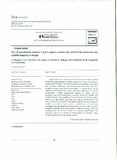| dc.description.abstract | Illegal substitution of meat products by traders either as closely
related domestic species or as bush meat is a common occurrence in
various parts of Kenya. This has implications on biosafety, food safety
and consumer confidence and subsequently the meat and meat
products industry both locally and export. In recent times, use of
molecular techniques have seen increased application in wildlife
conservation through conservation genetics in areas such as
population genetics, evolutionary genetics, molecular ecology and
wildlife forensics. We used DNA of the Cytochrome C Oxidase 1 gene
region as a bar-coding technique for species identification. The
accuracy of C01 as a marker was tested using five known samples of
wildlife species. Retail meat product substitution and bushmeat
prevalence was estimated from 99 unknown meat samples that were
randomly collected from meat traders in Nakuru County. The study
validated the use of C01 marker for species identification and
illustrated use of the marker in identification of unknown tissue
samples collected from the market survey. | en_US |

